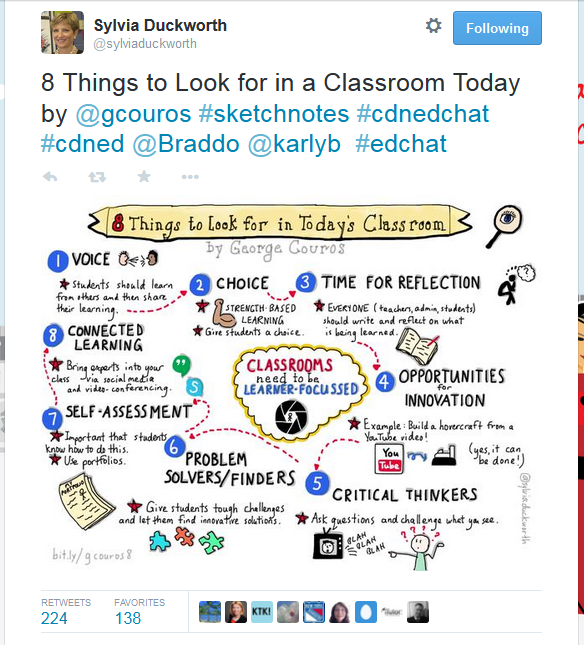A focus on learning
This graphic has been making its way around social networks over the past couple of weeks:
It`s based on 8 Things to Look for in Today`s Classroom by George Couros and beautifully drawn by Sylvia Duckworth (click the image to get to her twitter profile).
I’ve been watching it pop up on my friends’ feeds and each time I think – I like this…but there is something off for me. I couldn`t quite pinpoint what it was so I plopped the link into a draft blog post to be revisited. Today I sat down to write and boom, it came to me. Focusing on the learner is nebulous. Focusing on the learning, however, that has meat.
I think classrooms need to be learning focused. As a teacher I care about my students as learners. Deeply. Over the years I realized that the best way for me to care about them was to focus on their learning. On how best I could connect them to their learning. For Pete’s sake, our relationship existed because of learning!
It wasn’t about learning about each of their learning styles and modifying how I teach according to them – that doesn`t work. (“Sometimes we cripple students with our kindness.” Michael Doyle, in the comments from that last link)
So the focus is not so much on the learner (I know, taboo to say in the student centred zetgeist we now live) but on the learning.
Contrary to Will Richardson’s comment (if you haven’t read George Couros’ post, linked to above, go do it now), this IS an exciting time for teachers to teach because the act of teaching is shifting. We are all learning, we have no choice, and the classroom is where the action happens. I remember visiting Lori Centerbar`s classroom with a group of teachers to observe differentiation in action. At the end of the morning one of the teachers turned to me and said, “I learned more in the last 2 hours than I did in 4 years of teacher’s college.”
When I focus on the learning I think about:
– how to match what we are doing – the learning situations – with the subject-specific competencies in a way that makes sense to the learners I work with. All 8 of George Couros’ things reside here – voice, choice, reflection, innovation, critical thinking, problem solving, self-assessment, and connected learning.
– the fact that a diversity of stimuli helps to anchor what is being learned
– how I know that movement increases the flow of blood to the brain, making the act of learning, collaborating, creating, and making connections easier
– how to effectively incorporate the use of visuals because there is research that demonstrates we need them (and not via massively packed powerpoints…)
And, most importantly, I remind myself that as the teacher in the room I am the decisive element in the classroom. Students will learn from each other but I am the biggest model for learning in the room.

